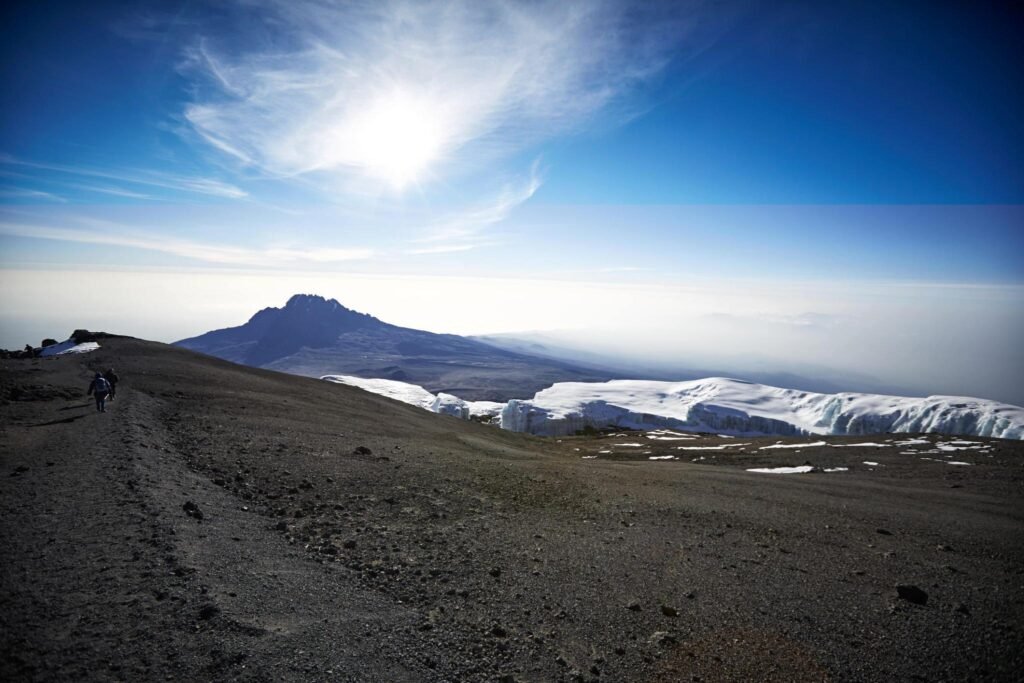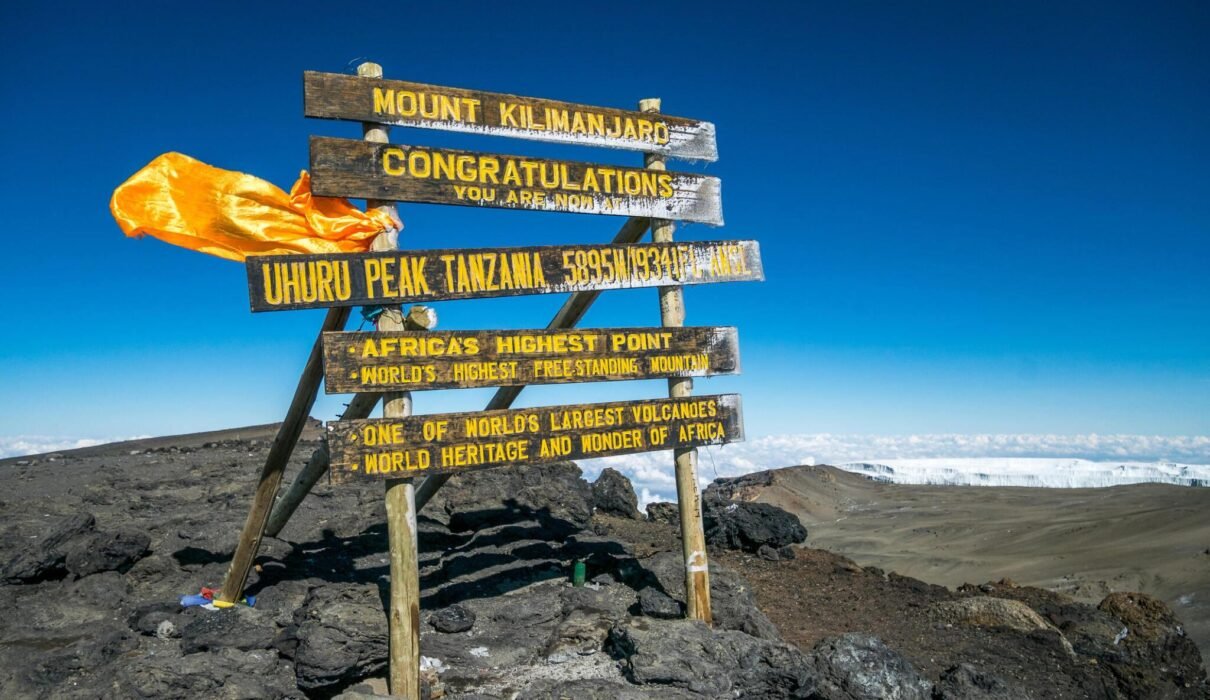Where Do the Kilimanjaro Climbs Begin ? : Mount Kilimanjaro, the highest peak in Africa, is a bucket-list adventure for many. One of the first questions every climber asks is: “Where do Kilimanjaro climbs begin?” The answer depends on the route you choose. Kilimanjaro has several access points or “gates” located at different sides of the mountain, each offering a unique approach to the summit. In this guide, we’ll explore the main Kilimanjaro starting points, popular routes, and essential tips to help you start your journey on the right foot
Learn more about Kilimanjaro climbs here.

Where Do the Kilimanjaro Climbs Begin ? : Main Starting Points for Kilimanjaro Climbs
Kilimanjaro has several entry gates that mark the beginning of different routes. Here are the most common starting points for the various trekking routes up Kilimanjaro:
Marangu Gate (1,870 meters)
- Route: Marangu Route
- Location: Southeast side of Kilimanjaro
- Notable Features: Known as the “Coca-Cola Route,” Marangu is the only route offering hut accommodations. It’s a popular choice for beginners.
Discover more about Marangu Gate and the route here.
Machame Gate (1,800 meters)
- Route: Machame Route
- Location: Southwest side of Kilimanjaro
- Notable Features: Known as the “Whiskey Route,” it’s more challenging than Marangu but offers stunning scenery.
Learn more about Machame Route starting point.
Lemosho Gate (2,100 meters)
- Route: Lemosho Route
- Location: West side of Kilimanjaro
- Notable Features: Lemosho offers a longer route, allowing for better acclimatization. It’s considered one of the most scenic routes to the summit.
Explore details on the Lemosho Route here
Rongai Gate (1,950 meters)
- Route: Rongai Route
- Location: Northeast side of Kilimanjaro
- Notable Features: This route approaches Kilimanjaro from the drier northern side, offering a quieter climb and unique views.
Get more information on the Rongai Route.
Where Do the Kilimanjaro Climbs Begin ? : How to Choose the Right Starting Point for Your Climb
Selecting the right gate and route depends on several factors, including your fitness level, experience, and the kind of experience you want. Here’s a quick guide to help you decide:
Marangu Gate (Best for Beginners)
If you’re looking for a less demanding route with huts for accommodation, Marangu Gate is the ideal starting point. This is the only route with permanent huts, making it a more comfortable climb, but it also has a lower success rate due to its shorter acclimatization time.
Machame Gate (For Adventure Seekers)
If you want a more scenic and challenging route, start at Machame Gate. The climb is more difficult but rewards you with varied landscapes and better acclimatization time, giving you a higher chance of reaching the summit
Lemosho Gate (Best for Scenic Views and Acclimatization)
Lemosho Gate is the best option if you want the most scenic experience and ample time to acclimatize. This route takes you through remote wilderness and increases your chance of summit success by allowing more days on the mountain.
Rongai Gate (For a Quieter Climb)
Rongai is the only route that approaches Kilimanjaro from the north, making it quieter and drier than other routes. If you prefer solitude and unique landscapes, this is a great option.
Learn how to choose the best Kilimanjaro route for your experience.
Where Do the Kilimanjaro Climbs Begin ? : Overview of Popular Kilimanjaro Routes
Each starting point corresponds to a specific route with unique challenges, views, and experiences. Here’s a brief overview of the most popular Kilimanjaro routes and what to expect:
Marangu Route
- Duration: 5-6 days
- Difficulty: Moderate
- Accommodations: Huts
- Notable Features: Only route with permanent huts, offering a more comfortable climb, but acclimatization can be challenging due to the shorter duration.
Find more information about the Marangu Route here.
Machame Route
- Duration: 6-7 days
- Difficulty: Challenging
- Accommodations: Camping
- Notable Features: Stunning scenery, with diverse landscapes from rainforest to alpine desert. Machame is one of the most popular routes due to its higher success rate.
Explore the Machame Route in detail.
Lemosho Route
- Duration: 7-8 days
- Difficulty: Moderate to Challenging
- Accommodations: Camping
- Notable Features: Considered the most beautiful route, Lemosho offers breathtaking views and an extended itinerary that improves acclimatization.
Discover why Lemosho Route is a top choice for trekkers.
Rongai Route
- Duration: 6-7 days
- Difficulty: Moderate
- Accommodations: Camping
- Notable Features: A quieter route with less rainfall, perfect for those seeking solitude. It offers views of the Kenyan plains and unique wildlife sightings.
Learn more about the Rongai Route and its benefits.
Where Do the Kilimanjaro Climbs Begin ? : What to Expect at the Starting Gates
When you arrive at your chosen Kilimanjaro starting gate, you’ll undergo several steps before the climb officially begins. These include registration, gear checks, and meeting your guides and porters.
Registration Process
At each gate, climbers must register with Kilimanjaro National Park authorities. This process helps monitor climber safety and tracks permits.
Gear Check
Before starting the climb, ensure all your gear is in order. Your guides will double-check that you have the necessary equipment, including appropriate clothing, trekking poles, and camping gear.
Meet Your Team
You’ll be introduced to your trekking team, which includes experienced guides and porters. These local experts play a crucial role in ensuring your safety, carrying your gear, setting up camp, and cooking meals throughout the journey.
Get more details on what to expect at Kilimanjaro’s gates.
Where Do the Kilimanjaro Climbs Begin ? : Essential Tips for Starting Your Kilimanjaro Climb
Prepare for Altitude
Kilimanjaro is a high-altitude trek, and altitude sickness is a common challenge. Start slow, drink plenty of water, and choose a longer route for better acclimatization.
Pack Smart
Make sure you have all the essentials, including a warm sleeping bag, high-quality hiking boots, waterproof clothing, and layers to handle the mountain’s varying climates.
Check out the ultimate Kilimanjaro packing list here.
Get Travel Insurance
Ensure your travel insurance covers high-altitude trekking. Emergencies on the mountain can happen, and having the right coverage is crucial.
Learn about the best travel insurance for Kilimanjaro climbs.
Where Do the Kilimanjaro Climbs Begin ? : Best Time to Start Your Kilimanjaro Climb
Timing is key when it comes to starting your Kilimanjaro adventure. The best time to climb Kilimanjaro is during the dry seasons:
- June to October: This is the peak climbing season, offering dry weather, clear skies, and ideal trekking conditions.
- January to March: Another great time to climb, with fewer crowds and slightly cooler temperatures.
Avoid climbing during the rainy seasons (March to May and November), as the trails can become slippery and more challenging to navigate.
Discover more about the best months to climb Kilimanjaro.

Where Do the Kilimanjaro Climbs Begin ? : Conclusion
Knowing where your Kilimanjaro climb begins is the first step toward an unforgettable adventure. Whether you choose to start at the popular Machame Gate, the scenic Lemosho Gate, or the quieter Rongai Gate, each route offers its own unique challenges and breathtaking experiences. With the right preparation and a trusted team by your side, your journey to the top of Africa’s highest peak will be an adventure of a lifetime.
For more information and expert guidance on planning your Kilimanjaro trek, visit Kilimanjaro Climb Specialist or Eddy Tours & Safaris.

